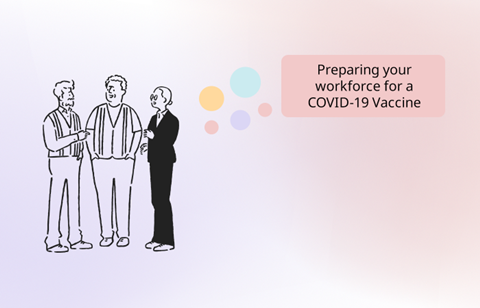
There’s a strong possibility that a COVID-19 vaccine will be approved in the coming months, but there is still uncertainty around when it will be available to the general public.
Whilst we wait for the release of the highly anticipated vaccine, let’s begin to address whether we will require our employees to be vaccinated, before they can safely return to the workplace.
Priority groups when there is a limited supply of COVID-19 vaccine
Firstly, immunisation with an effective vaccine is certainly a critical component of the strategy to reduce COVID-19 related illnesses, hospitsaltions, and deaths, and to help restore societal functioning. However, based on the information known, there will be limited supply to begin with. In fact, early eligible patients are expected to mirror prominent flu groups, including:
- All of those over the age of 50
- Those at high risk
- Care home residents and staff
- All health and care workers
Key considerations for a COVID-19 vaccine roll-out
Even though mass distribution and administration of millions of doses of vaccine will require extraordinary planning and time, employers need to start planning now, including the measures to take before employees return to work.
With this in mind, and critical to establishing a vaccine programme, we have put together a few key considerations for your business:
- Communication: If you choose to offer the vaccine, communicate with great care, responsibility and unity, as to the reasons behind the decision.
- Employee Priority: See above. The Huma Severity Risk Score can also be used to assess employee risk/likelihood of developing more severe illness should they get COVID-19.
- Exceptions: Some employees may not require a vaccine for medical or religious reasons. In these cases, you must plan for safety measures to protect these employees and the remainder of the workforce.
- Safety: Mandating a vaccine doesn’t satisfy your general duty to provide and maintain a safe working environment for employees. How else will you protect your employees?
- Location: Where will vaccines be administered and by who?
Furthermore, it should be noted that the precise dose required will be determined as part of clinical trials as well as the need for an annual or biannual revaccination booster shot to maintain durable protection.
Measures you can put in place right now to help employees return to work safely
Whilst awaiting the arrival of the approved vaccine against COVID-19, and in parallel to safeguarding the continuation of essential healthcare and public health services, we must work together to continue mitigating the transmission of the virus in the workplace.
Reducing the risk of transmission in the workplace can be done through non-pharmaceutical interventions, such as:
- Physical distancing, ventilation, and more regular cleaning
- Personal symptom tracking and severity risk scoring
- Daily health check-ins
- Awareness, health and safety training
An effective implementation of these measures can be achieved through the deployment of Huma Health Shield - a new digital health service, developed by UK-based healthtech company, Huma, and Johns Hopkins University.
Huma health Shield is the COVID-19 Return to Work App that can help prevent COVID-19 from entering the workplace, limiting further disruption, so your business can recover faster. Before coming to work, employees check if they are experiencing any symptoms, receive a personal risk assessment of developing serious complications and access official guidance on COVID-19 prevention.
The aim is to ensure safe, reliable and accessible tools for all workforces, until the vaccine becomes available.
To find out how Huma Health Shield can enable your transition back to work, get in touch via the website: www.huma.com/employers or email Lucy Button at lucy.button@huma.com











